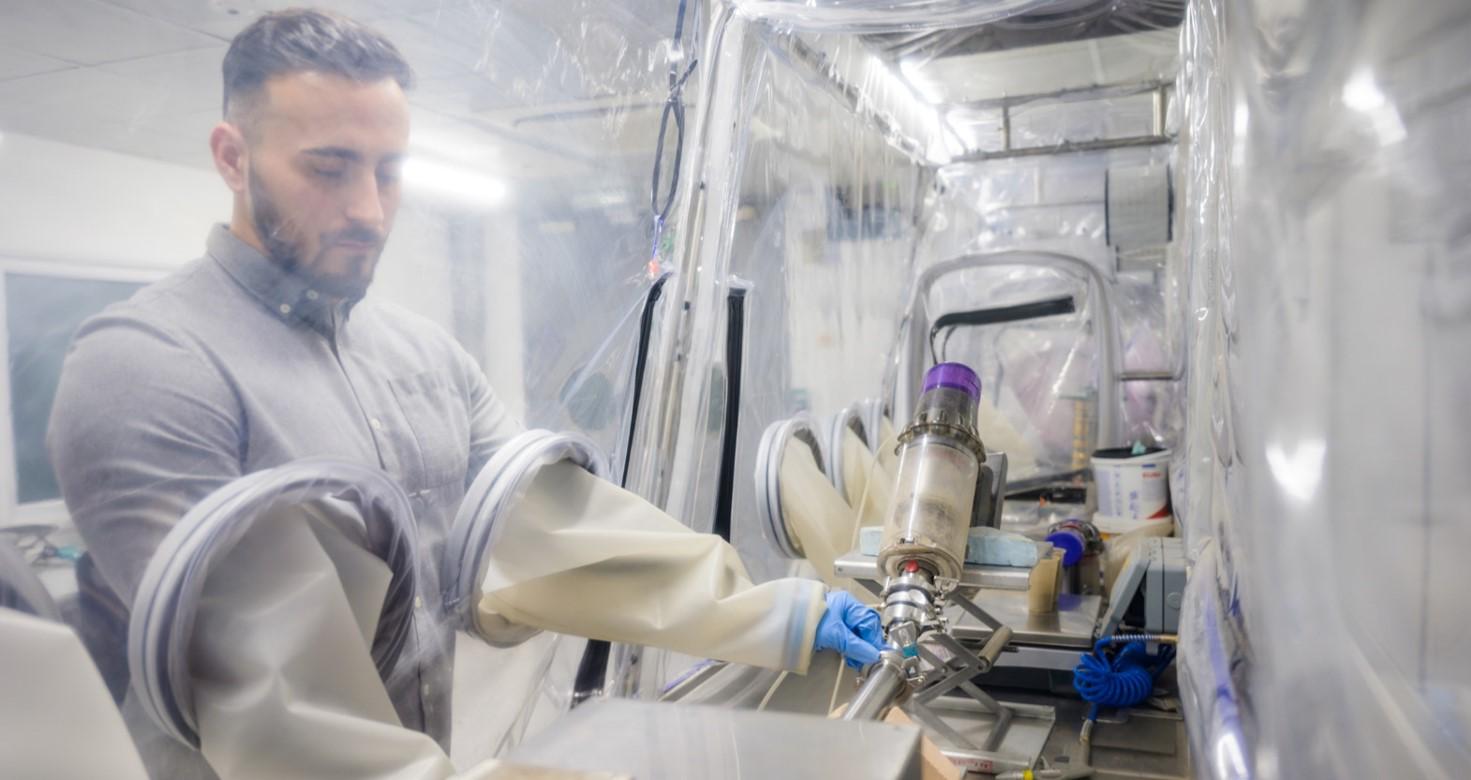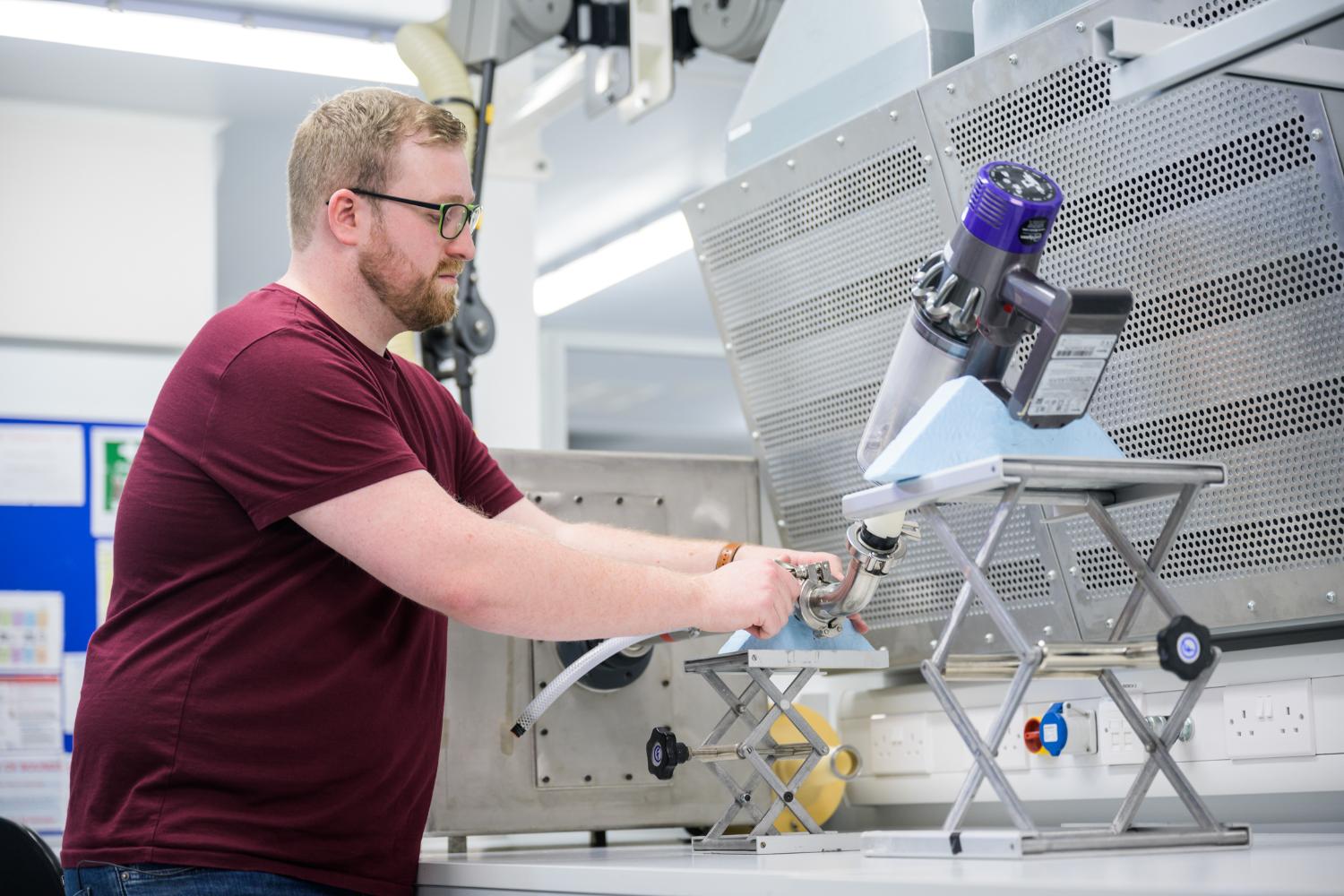

Tyler Hudd, unser Hausstaubtechniker, wiegt und misst die Staubmenge, die in einem normalen Haushalt gesammelt wurde.
Wir bei Dyson haben es uns zur Aufgabe gemacht, zu verstehen, was sich in Ihrem Staub befindet. Wir verfügen über eigene Labors, die die Bestandteile von Haushaltsstaub analysieren, und geben jedes Jahr Millionen von Dollar für Staubproben aus, damit wir wissen, dass unsere Geräte optimal dafür geeignet sind, den Staub richtig aufzunehmen - sogar den Staub, den man nicht sehen kann. Aber warum gehen wir so übertrieben weit? Unsere Ingenieure und Mikrobiologen beantworten Fragen dazu, warum wir Staub untersuchen, und teilen ihr Wissen darüber, was wirklich in Ihrem Haus lauert.
Was ist Haushaltsstaub?
Haushaltsstaub ist viel komplexer als die unterschiedlich grossen Partikel, die bei den üblichen Staubsaugertests verwendet werden. Echter Staub ist eine komplexe Matrix aus Bestandteilen wie Hausstaubmilben, Hausstaubmilbenkot, Bakterien, Schimmel, kleinen Insekten und Partikeln. Hausstaubmilbenkot, die Körper toter Hausstaubmilben und kleine Insekten gehören zu den Allergenen. Für das blosse Auge unsichtbar, sind sie auf verschiedenen Oberflächen in Ihrer Wohnung, wie Böden, Sofas und Betten, stark verbreitet. Eine einfache Tätigkeit wie das Sitzen auf einem Sofa bewirkt, dass Partikel in der Luft aufgewirbelt werden und eine allergische Reaktion auslösen können. Viele dieser Bestandteile lösen Allergien aus. Diese Allergene sind mikroskopisch klein. Die Grösse von Hausstaubmilbenallergenen, Schimmelpilzsporen und anderen Insektenallergenen liegt oft zwischen 0,5 und 5 Mikrometern. Zum Vergleich: Der Durchmesser eines menschlichen Haares beträgt etwa 50 Mikrometer
Warum untersucht Dyson Staub?
Die mikrobiologischen Einrichtungen von Dyson wurden vor fast 18 Jahren angelegt, und soweit wir wissen, sind wir weltweit der einzige Hersteller von Bodenreinigungsprodukten, der über eigene mikrobiologische Labors verfügt.
Wir wollten wirklich verstehen, was in Haushaltsstaub enthalten ist, konnten aber nirgendwo das nötige Fachwissen finden und beschlossen daher, unser eigenes Labor aufzubauen. Bei den Standardtests zur Beurteilung von Staubsaugern werden in der Regel Partikel verwendet, d. h. nur verschiedene Grössen von ähnlichen Partikeln. Unser Mikrobiologie- und Hausstaublabor ermöglicht es uns, die Bestandteile von echtem Staub und Schmutz zu untersuchen, die in echten Haushalten vorkommen. Wenn wir dies verstehen, können wir unsere Staubsauger besser an die Bedingungen anpassen, denen sie in realen Haushalten ausgesetzt sind.
Woher bekommen Sie all diesen Staub?
Wir bekommen ihn aus echten Haushalten, meist wird er von den Mitarbeitern gesammelt. Wir haben auch eine Kolonie von Hausstaubmilben, die wir betreuen und untersuchen. Anhand von Staubproben, die wir zu Hause gesammelt haben, werden mit Hilfe eines Rasterelektronenmikroskops (REM) Bilder erstellt, die es uns ermöglichen, die Bestandteile des Hausstaubs zu identifizieren, die dann in unsere Produktentwicklung einfliessen.
Welche Technologie kann zur Beseitigung von Staub und Feinstaub eingesetzt werden?
Wir erforschen seit über 15 Jahren die Technologie zur Entfernung von Staub und Feinstaub aus Wohnungen. UVC-Licht - ultraviolettes Licht, eine Art Strahlung - wird oft als Methode zur Vernichtung von Hausstaubmilben unter den richtigen Bedingungen genannt, was auch stimmt. In der Praxis muss UVC jedoch über einen langen und anhaltenden Zeitraum direkt auf das Objekt einwirken, das man abtöten will, aber normalerweise werden Staubsauger nicht auf diese Art eingesetzt. Im Grunde ist dies eine falsche Anwendung der Technologie.
Ionisatoren sind ein weiteres Beispiel für eine falsch eingesetzte Technologie in einem Staubsauger; bei der Verwendung wird zu viel Luft bewegt und nicht genug Ionisatoren erzeugt.
Wie lassen sich Staub und seine versteckten Bestandteile am besten entfernen?
Alle unsere Forschungen haben uns gezeigt, dass die beste Methode zur Entfernung von Bakterien, Pollen und Hausstaubmilbenallergenen darin besteht, sie vollständig aus Ihrem Zuhause zu entfernen. Deshalb konzentrieren wir unsere Bemühungen auf die Entwicklung von Staubsaugern, die Staub von Oberflächen aufnehmen, über unglaublich effiziente Zyklone verfügen und mit fortschrittlichen Filtern und Dichtungen ausgestattet sind, die verhindern, dass schmutzige Luft zurück in die Wohnung geblasen wird. Wir verbringen viel Zeit mit der Entwicklung unserer Filter und Dichtungen, um sicherzustellen, dass wir nicht nur den Staub auffangen, den Sie sehen können, sondern auch den Staub, den Sie nicht sehen können. Wir wollen auch sicherstellen, dass die Luft, die vom Staubsauger ausgestossen wird, sauber ist - tatsächlich können Dyson Geräte 99,97 % der Partikel bis zu einer Grösse von 0,3 Mikron auffangen. Zum Vergleich: Der Durchmesser eines menschlichen Haares beträgt etwa 50 Mikrometer.

Jonthan McGaughey, unser Ingenieur für Abscheidesysteme, testet die Filter und Dichtungen unserer Staubsauger, um sicherzustellen, dass die von unseren Geräten ausgestossene Luft sauber ist.
Fakten und Zahlen zu Staub
- Hausstaub besteht aus einer komplexen Matrix mikroskopisch kleiner Partikel. Die Grösse von Hausstaubmilbenallergenen, Schimmelpilzsporen und anderen Insektenallergenen liegt oft zwischen 0,5 und 5 Mikron - ein Mikron entspricht 1 % des Durchmessers eines einzelnen Haares.
- Staub enthält einen hohen Anteil an menschlichen Hautzellen. Ein durchschnittlicher Mensch verliert pro Woche etwa 28 g Haut, was in etwa dem Gewicht einer Tüte Chips entspricht.
- Hausstaubmilben ernähren sich von menschlichen und tierischen Hautschuppen, wobei jede Milbe etwa 20 Exkremente pro Tag produziert.
- 1 m2 Teppichboden kann bis zu 1000 Staubmilben enthalten.
- Wenn Sie sich in Ihrer Wohnung bewegen, werden Staubmilben und ihr Kot aufgewirbelt, der 30 Minuten lang in der Luft bleiben kann. In der Luft können sie leicht eingeatmet werden und allergische Reaktionen auslösen.
- Hausstaubmilben wachsen in dunklen und warmen Umgebungen, wie z. B. Matratzen. Betten können zwischen 100.000 und mehr als 1 Million Staubmilben enthalten.
- Haustierallergien sind weit verbreitet, aber das Tierfell ist oft nicht das Problem. Die Proteine in Speichel, Urin und Hautschuppen (abgestorbene Hautzellen) von Haustieren verteilen sich in Form von Staub.
- Wer Schuhe im Haus trägt, trägt Tierkot, Pollen, Düngemittel, Motoröl, Baumaterialien, giftige Verbindungen und verschiedene Organismen in alle Räume des Hauses.
- Die Gesundheitsrisiken für Säuglinge durch Schadstoffe im Hausstaub können 100-mal grösser sein als für Erwachsene. 1
- In unserem Hausstaub befinden sich im Durchschnitt mehr als 2000 verschiedene Arten von Mikroben. 2
Pressekontakt
-
Ennie Bertelli
Email:
ennie.bertelli@dyson.com -
Social media
Twitter: @dyson
YouTube: youtube.com/dyson
Facebook: facebook.com/dyson
Instagram: @Dyson
Instagram: @dysonbeauty
LinkedIn: Dyson
Pinterest: Dyson Technology
-
Kontakt
Um weitere Informationen zu erhalten, kontaktiere bitte unseren
-
Pressekontakt
-
